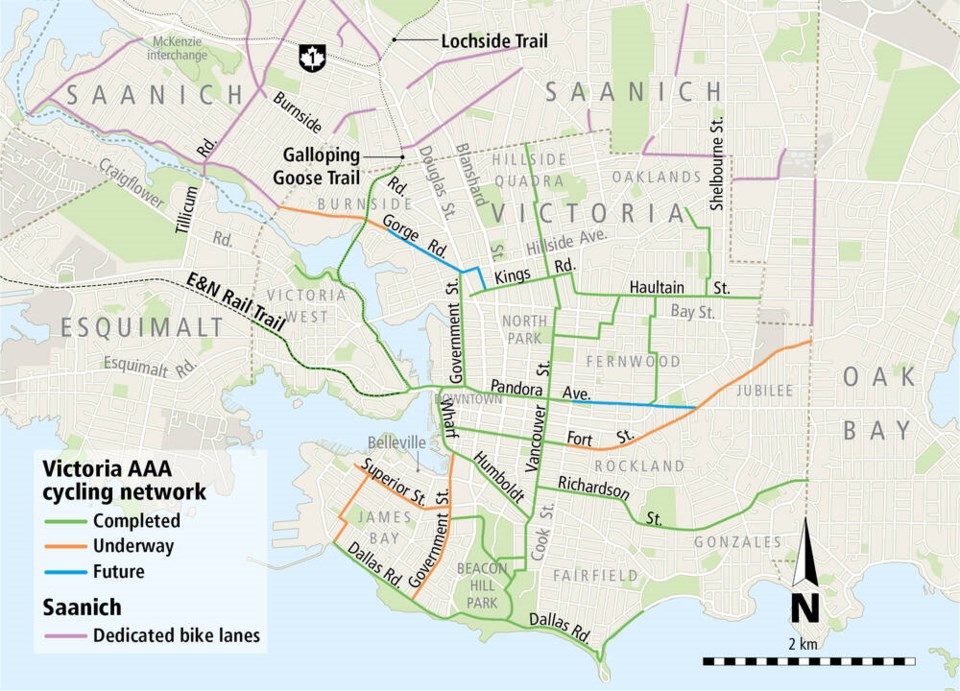A commentary by a Saanich resident who is an ardent cyclist.
It’s been roughly 10 years since the term “Biketoria” first appeared, and perhaps half that time since the idea began to be implemented in earnest. That makes it a suitable moment for an interim report.
My analysis divides the results into Outright Disasters, Questionable Judgments and Marginal Successes, with one Excellent Idea — with an asterisk.
My methodology relies mostly on volume of bike traffic, with an additional important evaluation of what is lost versus what is gained.
The gold medal winner in the Disaster category is Tillicum Road from Burnside to Gorge. No bikes! You’re about as likely to see an albino alligator as a cyclist in this bike lane; but you will see a long line of emission-fuming cars — with their drivers fuming at the empty bike lanes.
The real problem is that Tillicum is a vital artery connecting motorists from the Trans-sa╣·╝╩┤½├Į Highway and Burnside to Gorge, Craigflower and Esquimalt, and the bike lanes have transformed it into a bottleneck.
I live in the area so I like to think of it as my personal bike lane — except that I rarely use it; it almost never connects me from where I am to where I want to ride. With Gorge reopened to traffic, my use of it will fall from minuscule to zero.
Government Street north of downtown is also a Disaster, another important artery constricted to accommodate an absence of cyclists.
I predict that Fort Street east of Oak Bay Avenue will also be a significant artery squeezed by bike lanes with an absence of cyclists.
The Disaster designation is for important traffic arteries compromised to accommodate negligible cycling volume; the surge of bike use exists only in the imagination of the advocates.
The Pandora and Fort lanes are of Questionable Judgment. These two routes receive a measurable, even considerable volume of bike traffic, at least during the morning and afternoon commuter periods.
Does this justify the accompanying degradation of the vehicular transit route? The reasonable stream of bike traffic between 7 a.m. and 9 a.m. evaporates for the next six hours. During that period, vehicles idle at green lights, unable to turn right, while zero bikes go whizzing by in the adjacent lane.
The volume of bike traffic constitutes an argument for a bike lane, but did they have to so flagrantly disregard the needs of drivers?
While an argument can be made for those bike lanes on the basis of volume, that argument does not apply to Vancouver and Richardson.
These routes do not attract sufficient cycling volumes, and were already excellent routes for cyclists. They were residential streets that handled every kind of traffic without difficulty. There was no need to fiddle with them.
Cycling hasn’t been improved here, but driving has been made worse. Not a very good trade.
I predict the changes on Government south of Belleville will also be Questionable. I rode to and from work on this route for 20 years, and it was close to ideal.
The bike lane on Wharf is the Marginal Success. In terms of cycling volume, it is justifiable, handling much of the bike traffic coming over the bridge from the Galloping Goose.
But Wharf has a wretched design which seems intended to cause confusion and danger. Pedestrians, bikes and cars come at each other from every direction, including unsuspected ones.
Bike lanes between parking spots and the sidewalk — who thought that up? Right-of-way questions at crosswalks. Is it a crosswalk or a bike lane?
And at one end is the gong show at the intersection of Government and Humboldt. I have encountered more sticky situations on this route since the bike lanes were placed than in the previous 20 of cycle commuting on it.
There is one real Success: the multi-use path along Dallas Road provides a safe and convenient zone for all users. It does so without taking valuable space away from drivers — which is what makes it so great. (That’s the asterisk.)
We can use more cycling access; it goes wrong when it takes that space from drivers, who are not going away.
There is no shortage of additional detail that can be mustered to buttress the reasons listed here.
Still, a bit more must be said.
First, this bike-lane project has been expensive. A quick glance through the TC will disclose multiple uses for the money that went into an underused bike lane near you.
Secondly, any notion that vehicular traffic is on the wane contradicts overwhelming evidence. That McKenzie interchange is already bursting at the seams. Vehicular traffic will only increase.
Finally, municipal councils have been colonized in recent years by people and groups promoting extreme ideology at the expense of reality, practicality and common sense. Such ideas frequently come to grief on the rocky shores of the real world.
This is what has happened with Biketoria, or “active transportation” as it’s now called. The cost has been excessive, in money and outcomes.
It’s been a blunder of major proportions. And it’s got to stop.
>>> To comment on this article, write a letter to the editor: [email protected]



